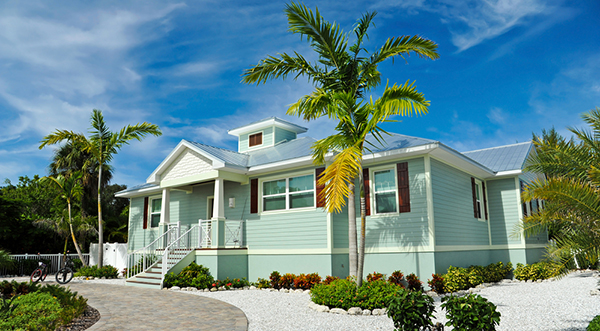The Art of Living by the Sea: Modern Coastal Architecture Trends
By Space Coast Daily // April 11, 2025

Living by the sea has always been a dream for many, and today’s architectural trends reflect a blend of luxury, sustainability, and functionality.
Coastal architecture has evolved beyond traditional beach houses, incorporating modern materials, open spaces, and energy-efficient designs. The goal is to create homes that not only offer stunning ocean views but also withstand coastal weather conditions while embracing the beauty of the surroundings.
As people continue to seek an effortless connection between indoor and outdoor spaces, coastal modern architecture has become increasingly popular. Whether designing a luxurious beachfront retreat or a minimalist seaside escape, modern innovations are shaping the future of coastal architecture style.
Defining Modern Coastal Architecture
At its core, modern coastal architecture emphasizes a seamless blend of nature and contemporary design. This style prioritizes open floor plans, expansive windows, and natural materials that complement the coastal environment.
Some defining characteristics include:
- Maximized Ocean Views: Large windows and glass walls allow homeowners to take full advantage of their surroundings.
- Sustainable Materials: Many homes incorporate weather-resistant wood, recycled glass, and energy-efficient insulation.
- Seamless Indoor-Outdoor Transitions: Open terraces, covered patios, and retractable walls enhance the living experience.
- Storm-Resistant Construction: Elevated foundations and reinforced structures help withstand harsh coastal elements.
When asking what is coastal architecture, the answer lies in its ability to balance beauty with resilience, ensuring homes remain functional and visually stunning in their natural settings.
Key Trends in Coastal Modern Architecture
As coastal contemporary architecture continues to evolve, new trends are shaping the way homes are built by the sea.
1. Sustainable & Eco-Friendly Design
With climate change concerns and rising sea levels, sustainability is at the forefront of coastal design. Architects are using solar panels, rainwater collection systems, and energy-efficient lighting to create self-sustaining homes. Green roofs and native landscaping further enhance a home’s ability to blend with its natural surroundings.
2. Open-Concept Living Spaces
A defining characteristic of coastal modern architecture is the emphasis on open, airy spaces. High ceilings, wide hallways, and minimal interior walls create a fluid connection between indoor and outdoor living. This design approach not only makes homes feel more spacious but also allows for better natural ventilation.
3. Elevated & Weather-Resistant Structures
Homes in coastal regions are often exposed to hurricanes, flooding, and saltwater erosion. Florida coastal architecture has adapted to these challenges by incorporating elevated structures, hurricane-resistant windows, and reinforced materials. Architects use concrete, steel, and composite materials to ensure longevity while maintaining aesthetic appeal.
4. Natural & Organic Materials
To complement the coastal setting, modern homes use materials like driftwood, reclaimed timber, and locally sourced stone. These elements enhance the warmth of the home while maintaining a strong connection to nature. Many homes also integrate glass and metal to create a sleek, modern aesthetic within coastal architecture style.
The Influence of Florida Coastal Architecture
Florida coastal architecture is one of the most well-known variations of modern beachfront design. With its unique climate and exposure to extreme weather conditions, Florida homes embrace key design elements such as:
- Elevated foundations to prevent flooding
- Large overhangs and shade structures for cooling
- Expansive balconies and outdoor living areas
- Resilient materials that withstand saltwater and humidity
Florida’s take on coastal contemporary architecture blends traditional beach house charm with cutting-edge technology, making it a model for other coastal communities.
Designing the Perfect Coastal Home
When designing a modern coastal home, architects and homeowners consider several factors to optimize comfort, durability, and aesthetics.
- Orientation & Views: Positioning the home to maximize natural light and ocean views enhances both beauty and energy efficiency.
- Color Palettes: Soft neutrals, whites, and ocean-inspired blues create a calming, sophisticated environment.
- Outdoor Living Spaces: Expansive decks, infinity pools, and shaded lounges enhance the connection with nature.
- Minimalist Aesthetics: Simple, clean lines keep the focus on the natural surroundings rather than excessive décor.
These elements help define what makes coastal modern architecture both stylish and functional, ensuring that homeowners enjoy the best of beachfront living.
Conclusion
The future of coastal architecture is rooted in sustainability, resilience, and modern design. Whether embracing Florida coastal architecture or experimenting with new innovations, homeowners are prioritizing eco-friendly materials, weather-resistant construction, and seamless indoor-outdoor living.
As the demand for coastal design grows, architects continue to push boundaries, creating homes that not only withstand the elements but also enhance the beauty of their natural surroundings. Through coastal contemporary architecture, modern seaside living has reached new levels of sophistication, blending tradition with forward-thinking design principles.












